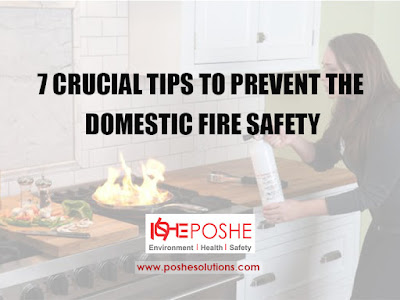Hey all, In this blog, you will get an idea about fire safety awareness and the ultimate guide to protect your dwelling from fire and the tips to prevent or reduce the domestic fires.
The Domestic Fire Safety is so Preventable by Anyone who attains the safety training in Chennai.
Do you know, the Fraction of time the fire will pass quickly. We all know fire is dangerous and life-threatening. Everyone must know fire safety awareness and need to know how the fireworks, how fire can cause in domestic as well as workplace, what are methods of fire safety in the workplace etc.
For workplace fire safety, there should be many safety courses and safety training to prevent fires. One of the best Corporate training is provided by Poshe Solutions and also offering more Industrial Fire Safety Courses in Chennai.
Alright, Now we see Some of the tips to prevent the Domestic Fire safety at home. Obey the Safety Rules and live Safety life forever.
- Do not Leave pan unattended while Cooking
- Keep matches, lighter out of reach of Children's
- Keep portable heaters and the lighted candles away from the clothes, curtains, or furniture.
- Do not overload spike busters, that causing short circuits, electrical fires
- Use portable wet chemical fire extinguisher at the kitchen
- Shut off LPG valve when not in use
Now Here we discuss what are the elements that cause the fire Easily at home. If the fire can cause it spreads quickly so be aware of following to reduce or avoid fire at home.
In the Fire Safety Training in Chennai, Helps to Overcome the fire and understands the fire safety foundations to preserve your life and your families, friends, neighbours
- Clothing Dryers - lint in the dryers causes fire easily. Maintain the lint filter Clearly for every load.
- Flammable Liquids - the highly flammable liquids such as cleaning agents, adhesives, gasoline are fireable at high temperatures so better keep that product in cool temperature area.
- Electrical Appliances - Faulty or Electrical detected wire problems in the Appliances may cause a fire. It is dangerous to use the high wattage device of overloaded outlets, so it's better to spread out that type of appliances.
Conclusion
If you feel the above Safety Tips are the common awareness but that are more essential. In case if you in stressed that time the basic things are effective for you to reduce the fire at home.
Fire Safety Training for the Workplace as well as domestic could be Conducted to create awareness and get the informational knowledge of how to prevent easily and quickly in a smart way.
Taking the elemental measures will not only save a ton of hassle and your precious belongings but also your loved ones!
Thanks and Regards
Priya - Safety Training Institute
Nebosh Course in Chennai | FIRE SAFETY COURSE IN VIZAG




